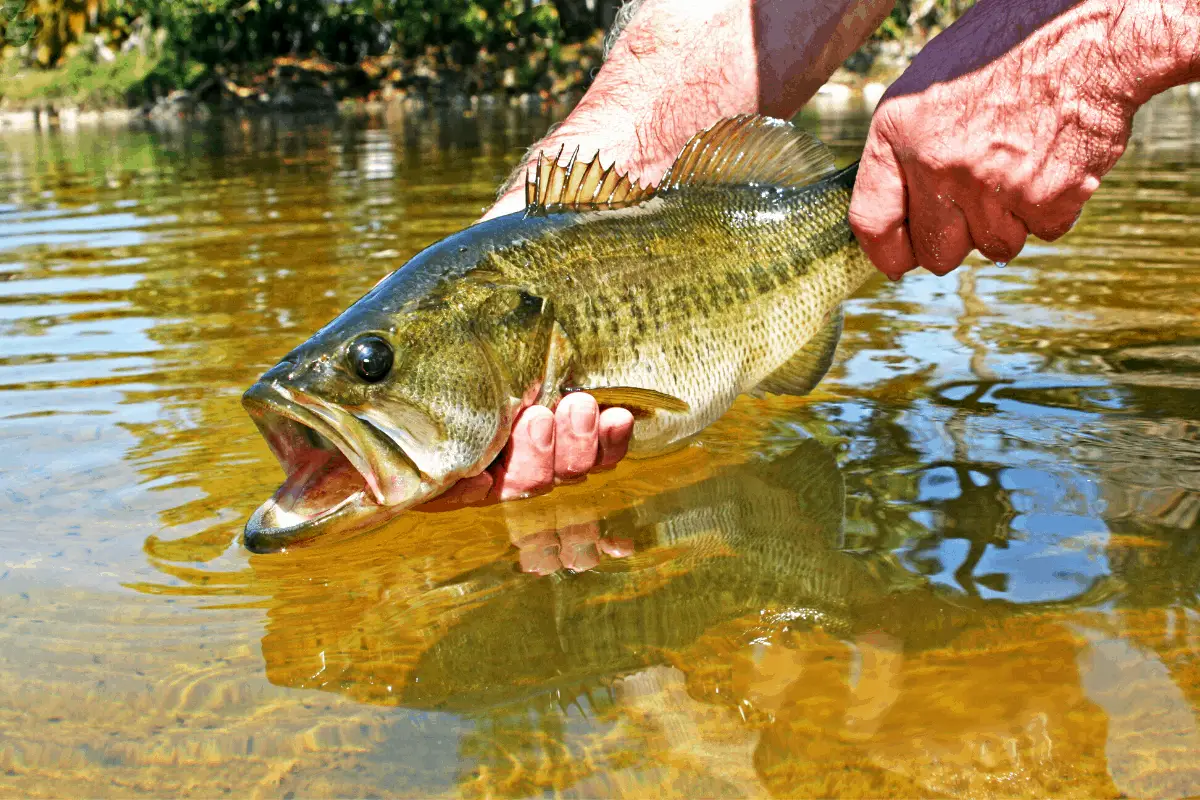The great thing about bass fishing is that we are always learning. Likewise, the frustrating thing about bass fishing is that we are always learning. So, how do we get better and can these tips help anglers catch more fish quickly?
To get better at bass fishing, anglers should focus on each of the following areas:
- Rigging Lures Correctly
- Casting Accuracy
- Willingness to Fish in Heavy Cover
- Fish Slower
- Cover the Entire Water Column
It is a very true statement that 10% of the water holds 90% of the fish. This article will break down the previous five topics in detail so the next time you go fishing, the odds are in your favor.
#1 Rig Those Lures Correctly
This seems obvious, but unless you have a bass fishing mentor that can show you quick and easy rigging methods, this can keep you from catching fish.
Literally.
If everyone fishes long enough, they will catch a bass – eventually. Our goal is to catch more bass more of the time and under a variety of conditions. Lure rigging is one of the simplest and most effective corrections anglers can make – especially if they are new to the sport.
Tie The Line Directly to the Lure (In Most Situations)
When anglers are first learning to bass fish, the overwhelming number of lures and techniques often forces them to use a snap on the end of their line.
A snap makes switching out lures fast and simple, and yes, many anglers catch fish when using a snap. You can catch more if you remove it. Let me explain.
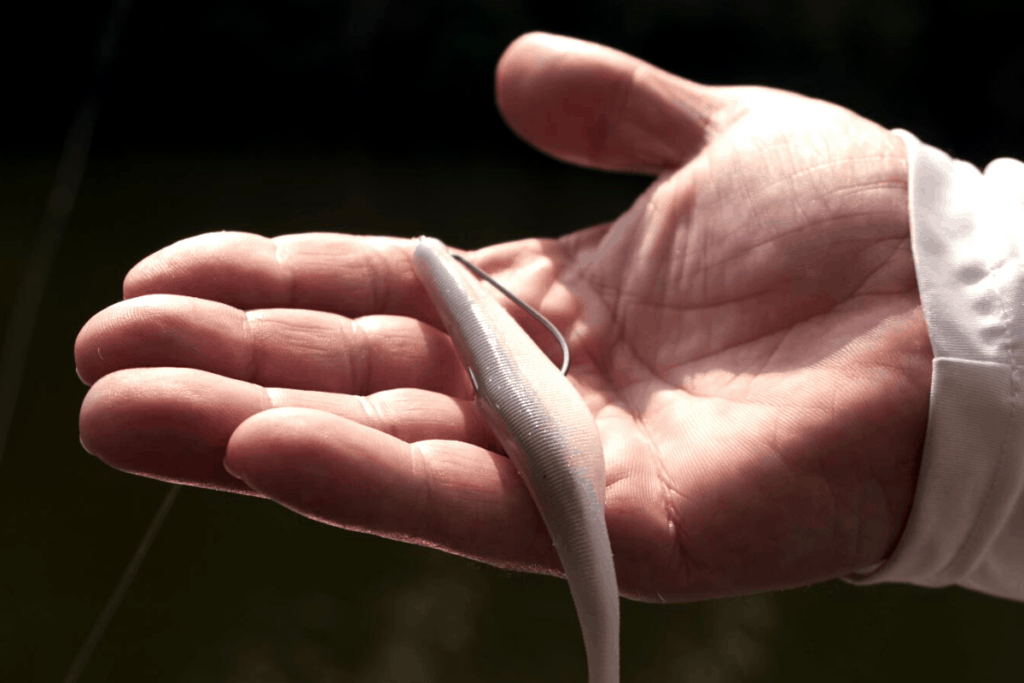
Better Lure Action
In most instances, a snap impedes or reduces the action a lure has. Soft plastics, crankbaits, jigs, etc., work better when tied directly to the lure.
The one exception to this is when using a big glide bait. These lures have a wider side-to-side action when a large snap is used. Think of it like a pivot point that allows the glide bait to swing more.
But, for just about every other type of lure, it is better to leave the snap in the tackle box.
Tendency to not Retie
No angler likes to get a bite, set the hook on a monster, and then have the line break.
Using a snap means anglers are more likely to not check the line for frays and retie when needed. That is why the snap is on there in the first place, to eliminate the need to retie.
Even the most powerful and abrasion resistant lines eventually need to be snipped off and retied.
Alters the Fall and Sink Rate
Bass love to chomp on baitfish as they fall helplessly through the water column. A natural fall that mimics what is really happening in nature is key to getting more bites.
A snap can add additional weight to one side of the lure and alter the way it behaves on the way down. When the bass are really biting it may not be that noticeable, but on those tough days when everything needs to be perfect, it can make a huge difference.
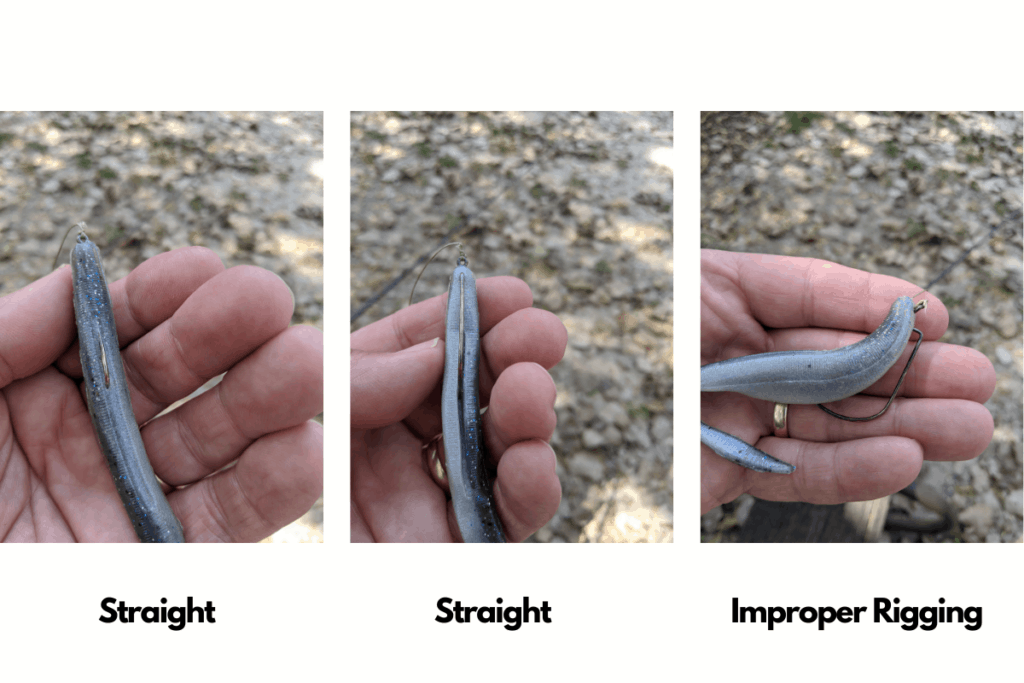
Make Sure the Soft Plastic Lure is Straight
I have been fortunate to help hundreds of new anglers get into the sport of bass fishing. One of the natural progressions is to move from hard baits to soft baits.
The most common problem I see is that the soft plastic bait is not rigged straight.
A soft bait that is rigged crooked, or bunched up, can drastically alter the way it swims and falls through the water column. The result is an unnatural presentation that will struggle to get bit on most days.
An easy way to tell if a lure is rigged straight is to reel it back to the boat just under the surface of the water. If it rolls in circles on the way back, it is rigged crooked.
Most soft plastic manufacturers now include lines or pockets on their baits to help anglers identify the exact middle of the lure. Take care to have the hook point line up perfectly parallel to this line.
Another common issue is not keeping the nose of the lure straight by the eye of the hook. This is a notorious action killer and can cause horrible line twist. Many hooks come with “keepers” that will help anglers keep the soft plastic lure rigged correctly. You can also use a drop of super glue to keep the lure in place.
Taking the extra time to make sure the plastic is rigged in the correct manner will translate to more bites.
#2 Casting Accuracy can Make You a Better Angler
This is one area that all anglers, no matter the experience level, are constantly working on.
There are many, many days when missing the target by just a few inches will mean no bite and no bass.
Yes, baitcasting equipment is more accurate than spinning gear, but there are lots of anglers that are experts at placing a lure exactly where they want it with spinning gear as well. Practice with what you are comfortable with and progress to baitcast equipment when you are ready.
The dirtier the water, the more accurate the cast needs to be.
In clear water, bass are more sight-oriented predators. In dirty water, the lateral line becomes more important and bass sense the vibrations the lure gives off. The bass are also more likely to hold very tight to cover or structure in dirty water and not chase as far.
Practice in Your Yard
When I was first preparing for my early tournaments, I knew that my accuracy needed to be at another level.
I setup some concrete blocks in the yard and positioned them so I was standing above the grass at the same distance the boat deck was from the surface of the water. I then used the shadows of the tree branches to simulate a brush pile in a lake or river.
I spent many hours flipping and pitching a 1/2oz jig to the nooks and crannies of those shadows.
This practice correlated with many more fish being caught.
Short distance accuracy is the first thing to work on. As you get better, make sure to work on presentations farther away to simulate different situations you may run across.
Learn to Cast With Both Hands
From the very beginning, learn to become an ambidextrous angler.
There are a myriad of situations where you cannot make the cast you want with your dominant arm. The sooner you can master casting with both hands, the sooner you will be putting lures where you want them on a more consistent basis.
Being able to cast with both hands also translates to a greater number of opportunities in a day. This means you up the odds of getting a bite when you present the lure more often.
No longer will you have to reposition the boat or stand at a different place on the shoreline to make the cast easier. You can switch hands and put that lure where you want it.
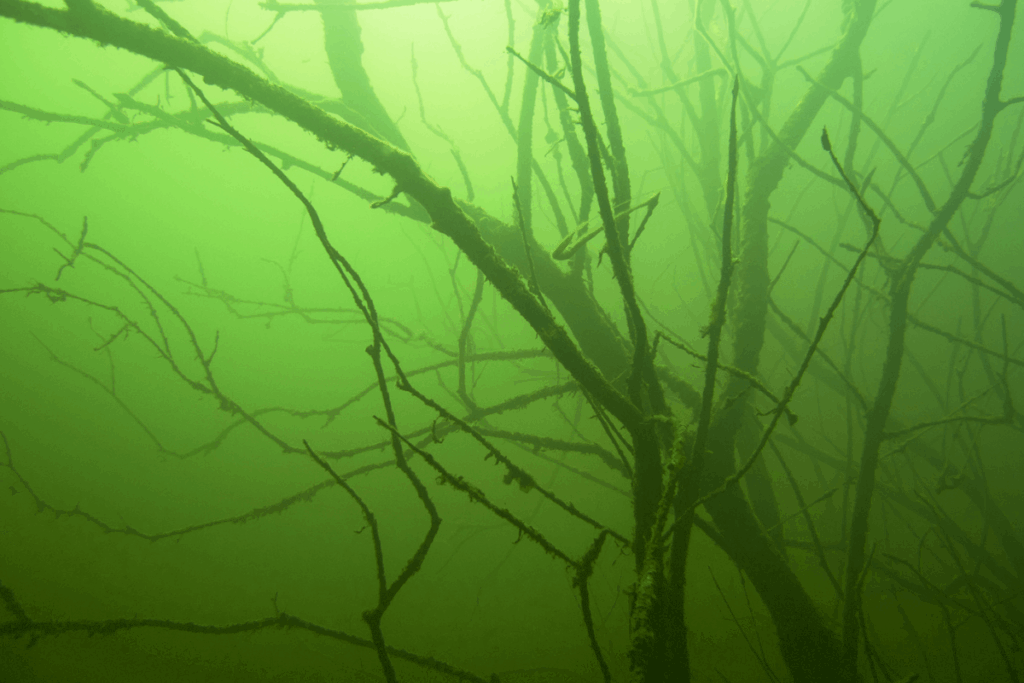
#3 Be Willing to Put Those Lures in Heavy Cover
No one likes to get snagged – especially if you are fishing from shore.
Lures cost too much money to leave them stuck in a brush pile, but that is where the bass like to hide.
Bass can nestle up along anything that makes them feel safe and secure. Often they are not willing to leave that safety to chase a lure. The lure needs to come to them.
There are a couple of things that you can do to help build your confidence when casting to the gnarliest cover you can find.
Use Braided Line
Braid is very abrasion resistant and is tough to break. Using braid can give you the positive outlook that if you get a lure stuck, most likely you will recover it. I have hauled some pretty stout branches all the way back to the boat when using braid.
Even if your water is super clear, braid can still be effective when used in very heavy cover. The lure likely will suddenly appear, or drop on the fish’s nose, and they will react before the line is even seen.
Use Soft Plastics that are Compact
By compact, I mean soft plastics that do not have huge appendages dangling off of them. A sleek, streamlined lure, will slip through brush, weeds, and heavy cover easily. That also means that it will pull out of the thick cover with less effort.
Soft plastics are also a smaller hit to the wallet when the inevitable stuck lure happens.
It is also critical to let your lure fall on a slack line.
If the line is taught, it will pendulum down and possibly swing into an area that is harder to get out of because of the angle. A lure that drops straight can be pulled straight back up if needed by parking the boat as close to the cover when your are hung up.
A Heavy Cover Mindset
The last piece to become a better heavy cover angler is to change our mindset.
Just pitch that lure in there and be confident. Worry about getting the bass out of there once you get one hooked.
Finding them and getting them to bite must come first. As long as you keep pressure on the bass, you can reach down in that brush and get them out if needed.
I’ll admit. It took me a long time to work up to the point where throwing lures into heavy cover doesn’t bother me. I have caught so many big bass in these areas, that I know my odds of catching a good fish go way up when searching where they hide.
#4 Fish Slower
This one is a lot harder than it first sounds.
Most anglers know this, but it is still very difficult to accomplish. I have spent many, many, hours watching and filming bass underwater. This unique perspective into observing bass in their natural environment has taught me a couple of things:
- Bass are very curious – they will investigate just about everything that drops into their watery world. This doesn’t mean they will eat it.
- They are most likely to inhale a lure when it is sitting still on the bottom – I have watched many bass turn away once the lure starts to move too much.
So what does fishing slow look like?
If you are an angler that loves to keep moving and has a hard time keeping the bait still, maybe slow fishing for you is not moving the lure for 5 seconds.
If you are able to fish slower than the average bass angler, maybe your version of fishing slow is to keep the lure still for 30 seconds.
Move the lure less than you are now and you are fishing slower.
When it is time to move the lure the most effective method I have used over the years is to drag the bait. Let it just slide across the bottom.
Think of a crawfish.
Even when this favorite food source is moving in a hurry, it rarely comes up off the bottom very far. The more we can imitate what is already naturally occurring on the bottom of the lakes and rivers, the more likely we are to get that precious bite.
#5 Cover the Entire Water Column When Bass Fishing
Most anglers fish the middle of the water column. It works.
We can increase the number of fish we catch when thinking about the entire water column from top-to-bottom.
Let’s use a dock as an example.
There are three distinct places a bass can possibly hold when relating to a dock.
The Bottom
When the sun is high, the clouds are gone, and the wind has stopped, bass will often head to the bottom.
High pressure situations drive the zooplankton down. This brings the entire food chain down with it.
During these weather conditions, bass like to sit in the shade all the way under the docks.
The Middle
This is the toughest situation for bass anglers to tackle when approaching a dock. It is common that bass will suspend alongside the pilings. These fish are often in a neutral mood and refuse to move up-or-down.
Lures presented to them must often be counted down and then swam horizontally while maintaining the proper depth.
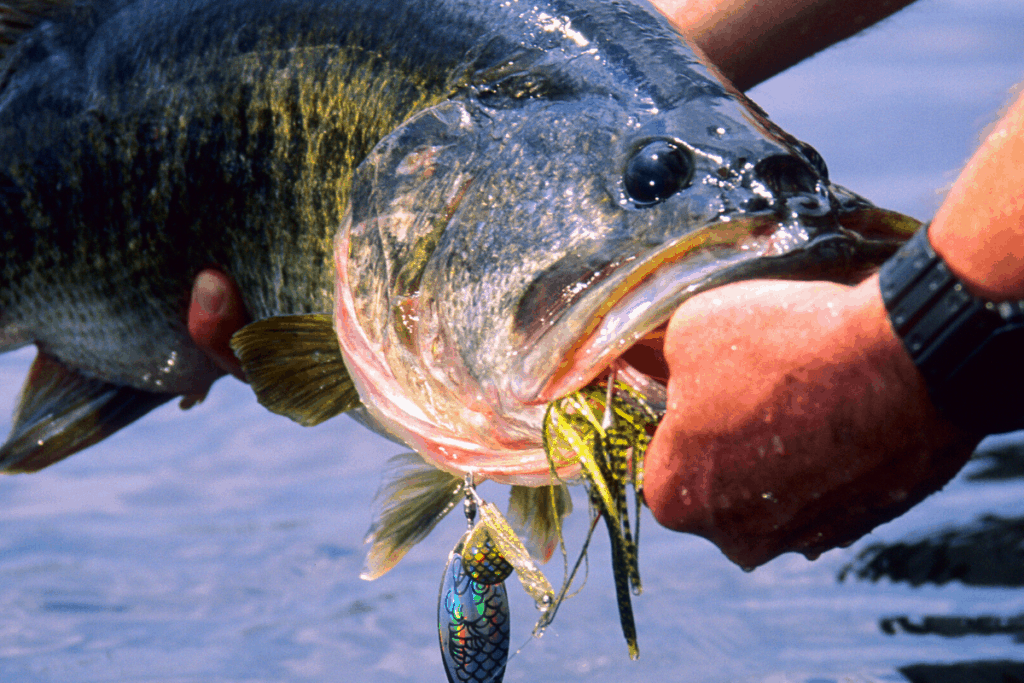
The Top
Filming bass on docks has taught me that they love to sit underneath the physical structure of the platform.
This can be hanging under the floats, walkways, or boats that are parked there. These fish are rarely visible to the angler – especially on larger dock systems.
Lures targeted to these bass must run right under the surface and as close to the hard cover as one can possibly get them.
Apply This Strategy to the Rest of the Water
Covering the entire water column ups the odds of finding exactly where the fish are hanging out on a particular day.
As mentioned earlier, high pressure days often find the fish on the bottom while low pressure days will see more activity in the mid and upper portions of the water column.
If you have a large population of baitfish in your home water, like shad, then locating schools of shad on your electronics can help to clue you in to what depth bass may be hanging at. This is definitely the case if the bass are keyed in on the baitfish as the primary food source.
Final Thoughts
If you concentrate on these five areas, I think that you will find your bass fishing will jump to the next level.
Some things, like rigging the lures straight and casting accuracy, will come along quickly. You can vastly improve these factors in one outing.
The last three, fishing heavy cover, fishing slower, and fishing the entire water column, take more practice and a concerted effort to make them happen.
These three areas, when worked on, can take you from catching just a few fish to landing many more bass and larger bass.
Enjoy the process. We are always learning and getting better.
Tight lines. Be safe and make sure to encourage someone today. You never know how you may change their life forever.
Isaiah 6:8

